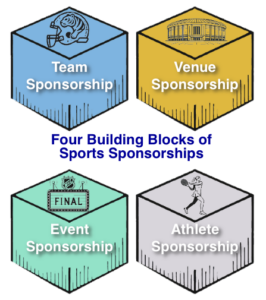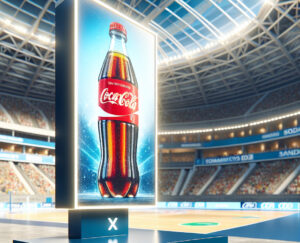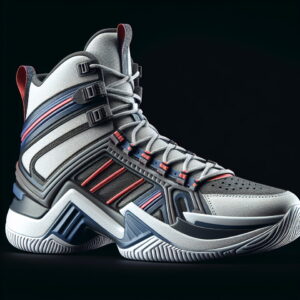The Power of Sports Advertising for Brands
Sports sponsorships have become a vital strategy for brand marketers. They enable brands to align with the passion and loyalty of sports fans and forge powerful emotional associations.
Why Use Sports Sponsorships for Brand Building?
Sports sponsorships are powerful tools for building brand identity. They enable companies to connect with audiences through shared passion and excitement. By partnering with popular teams, events, or athletes, brands can enhance visibility, foster emotional loyalty, and create lasting impressions that resonate far beyond the field or court.
Enhance Brand Visibility and Awareness
Sponsorships place brands in front of millions through logo placements on jerseys, arena signage, or televised events. These integrations supply frequent exposure — the kind that keeps the brand top of mind for consumers. Sponsorships can also amplify awareness by associating with high-profile events, increasing brand credibility and recall.
Build Emotional Connections and Loyalty
Sports evoke strong emotions, from the thrill of victory to the agony of defeat. Brands that support teams or athletes can tap into the psyches of passionate sports fans. They often transfer team admiration to its sponsors. This kind of brand adoption creates bonds that extend beyond the game.
Three Examples of Successful Brand Image Building Through Sponsorships
- LVMH, the world’s largest luxury group, became a major sponsor for the 2024 Paris Olympics, investing €150 million ($156 million) in the partnership. The sponsorship included designing the torch relay and creating uniforms for the French Olympic team. These prominently featured LVMH’s brands in various aspects of the Games. This association enhanced LVMH’s prestige and solidified its connection with Paris, providing significant global exposure.
- Airwallex, a Melbourne-based fintech company, partnered with the McLaren Formula 1 Team to boost global awareness and trust in its brand. This multi-year sponsorship highlights Airwallex’s technological innovation and reliability, aligning the company with the high-performance world of Formula 1 racing. As a result, 70% of consumers were more inclined to choose Airwallex for payments, and 58% trusted the brand more due to the sponsorship.
- Hugo Boss partnered with Formula One, tennis, boxing, skiing, cycling, equestrian events, and the NFL. By engaging with high-profile athletes and major sports teams, Hugo Boss established stronger market positions in the U.S. casualwear segment.
Understanding Sports Sponsorships
Understanding sports sponsorships begins with recognizing the four main types. Each offers unique opportunities for brands to connect with audiences, enhance visibility, and align with the excitement and passion of sports. Let’s look at each one.
The Four Major Types and How They Work

- Team Sponsorships: Team sponsorships involve supporting an entire team, including opportunities for logo placement on uniforms, equipment, or promotional materials. These tactics build brand visibility and foster loyalty among dedicated fanbases.
- Event Sponsorships: Event sponsorships connect brands with specific tournaments, games, or competitions. They amplify visibility through signage, broadcasts, and on-site activations. They can reach diverse and engaged audiences.
- Athlete Endorsements: Athlete endorsements leverage the popularity and influence of individual athletes. By associating with a well-known sports figure, brands gain credibility and connect with fans who admire the athlete.
- Venue Sponsorships: These involve naming rights or branding opportunities within sports arenas and stadiums. They provide ongoing exposure to event attendees and media coverage.
Evolving Advertising in Sports Sponsorships
Sports advertising has evolved from simple print ads to today’s sophisticated strategies that engage audiences across multiple platforms. As consumer preferences shift toward emotional connections and experiential marketing, sports sponsorships have emerged as a powerful tool.
Unlike traditional ads, sports sponsorships allow brands to integrate naturally into moments of excitement and loyalty. From the dawn of logo placements on jerseys to modern digital integrations, the evolution of advertising has made sports sponsorships an essential strategy for reaching diverse and engaged audiences.
From Theory to Practice: Sponsorship Activations
Knowing is good, but doing is better. Let’s examine how we can put theory into practice. We’ll begin with sponsorship activations.
Introduction to Sponsorship Activations
Sponsorship activations transform agreements from static partnerships into dynamic experiences. They involve creative strategies to engage fans, amplify brand exposure, and solidify the connection between the sponsor, event, and audience. Activations can include on-site promotions, social media campaigns, and interactive fan experiences.
Maximize Benefits Through Activations
Activations bring sports sponsorships to life by driving audience engagement and creating memorable interactions. These strategies enable brands to move beyond logo placements, leveraging their sponsorships to achieve greater visibility, emotional resonance, and ROI.
Explore SponsorCX’s Activation Guide
Visit SponsorCX’s online guide to activations to explore actionable strategies for effective activations. This resource provides practical insights and examples to help you turn sponsorship agreements into impactful marketing moments that connect with your audience. Start elevating your sponsorship strategies today.
Strategies for Sports Sponsorships that Work
Identify the Right Partnerships
- Selection Criteria: Choosing the right sports sponsorship involves evaluating audience demographics, reach, and the potential for brand exposure. Consider the sport’s popularity, the size of its fan base, and how it aligns with your marketing and social consciousness goals.
- Importance of Alignment: Sports sponsorships that work rely on authentic alignment between the brand and the sport. Partnerships that resonate with shared values and appeal to the same target audience create stronger connections. Such alignment ensures the sponsorship feels natural, fostering trust and loyalty among fans.
Leverage Brand Visibility
- Effective Brand Placement Strategies: Strategic placement of logos and messaging in high-visibility areas, such as jerseys, arena signage, or digital broadcasts, provides optimal exposure to engaged audiences. Consistent and creative brand integration across platforms enhances recall and recognition.
- Merchandising Opportunities: Co-branded merchandise, including apparel, accessories, and collectibles, amplifies visibility and generates an additional revenue stream. These items deepen fan engagement and extend the reach of sports sponsorships beyond the event. They have the power to turn loyal fans into brand ambassadors.
Engage the Fan Base
- Create Interactive Experiences: Interactive experiences, such as on-site activations, contests, or digital engagement campaigns, encourage fans to actively participate with the brand. These initiatives deepen the connection by making the sponsorship memorable and fun.
- Exclusive Offers for Fans: Providing exclusive discounts, giveaways, or early access to products enhances loyalty and strengthens the bond between the brand and fan base. These offers show appreciation while turning casual spectators into enthusiastic customers.
Five Highly Successful Sports Sponsorships
Coca-Cola and the Olympic Games

Coca-Cola’s partnership with the Olympic Games is a prime example of successful sports sponsorship. This collaboration spans nearly a century and aligns Coca-Cola with the Olympic Games’ values of unity and global celebration. Through exclusive branding, event activations, and storytelling, Coca-Cola connects with millions worldwide, reinforcing its identity as a symbol of joy and togetherness.
Nike and Michael Jordan (Air Jordan)

Nike’s partnership with Michael Jordan is a landmark example of successful sports sponsorship. By creating the Air Jordan brand, Nike turned an athlete endorsement into a cultural phenomenon. This collaboration revolutionized sports sponsorships in advertising, blending performance and style while fostering deep connections with basketball fans and fashion enthusiasts.
Pepsi and the NFL

Pepsi’s long-standing partnership with the NFL showcases the benefits of sports sponsorships in advertising. As the official sponsor of the Super Bowl Halftime Show, Pepsi combines massive visibility with entertainment-driven branding. This collaboration reinforces Pepsi’s identity as a fun and energetic brand while engaging millions of passionate football fans yearly.
Red Bull and Extreme Sports

Red Bull’s sponsorship of extreme sports redefines sports sponsorships in advertising. Red Bull connects to thrill-seeking audiences by aligning with high-adrenaline events like cliff diving and motocross. Its strategic branding, such as the Red Bull Rampage and Air Race, reinforces its image as a bold, adventurous brand, energizing consumers worldwide.
Adidas and the FIFA World Cup

Adidas’s partnership with the FIFA World Cup is a standout example of sports sponsorships in advertising. As the official sponsor and ball supplier, Adidas enjoys global visibility and aligns with soccer’s passion and prestige. This collaboration strengthens Adidas’s brand image as a leader in sports innovation while reaching millions of devoted fans.
Innovative Approaches in Sports Sponsorships
Innovative approaches in sports sponsorships are transforming traditional advertising by creating dynamic, engaging experiences that connect brands with audiences in meaningful ways. Here are three on the forefront:
Digital Activations
Brands are leveraging digital platforms to create immersive fan experiences. Social media campaigns, virtual reality (VR), and interactive apps amplify sponsorships by engaging fans directly. For example, Heineken’s #ShareTheSofa campaign allowed fans to interact with soccer legends on Twitter during UEFA matches, enhancing their game-day experience.
Community Involvement and Grassroots Programs
Sponsorships that invest in local communities build goodwill and lasting connections. Grassroots programs encourage participation and foster loyalty. Nike’s partnership with community sports programs, like the Nike Community Ambassador initiative, promotes access to sports while reinforcing the brand’s commitment to empowering athletes at all levels.
Athlete Co-Branding Initiatives
Collaborating with athletes allows brands to combine star power with creative marketing. Under Armour’s partnership with Steph Curry includes exclusive product lines that showcase Curry’s influence and Under Armour’s focus on performance and innovation, which resonates with fans and consumers alike.
Measure the Impact of Sports Sponsorships
Measuring the impact of sports sponsorships is essential for understanding their effectiveness, optimizing strategies, and ensuring a strong return on investment. The following are musts.
Use Metrics and KPIs to Evaluate Effectiveness
To measure the success of sports sponsorships, brands should focus on key metrics and performance indicators. These include awareness, engagement rates, media exposure, and audience reach. Social media analytics, surveys, and sentiment analysis help assess fan interaction and overall campaign impact. Monitoring website traffic and lead generation during the sponsorship period provides insights into consumer interest.
Calculation ROI and Financial Impact
Calculating ROI is essential for understanding the financial benefits of sponsorships. Brands can measure direct returns through sales growth, leads, and indirect impacts such as enhanced brand loyalty. Evaluating cost-per-impression and media value helps compare sponsorship expenses to gained value.
Quantitative Measurement
Her are three sports sponsorship examples demonstrating how companies can quantitatively measure sponsorship impact:
- Heineken and UEFA: Heineken’s UEFA Champions League sponsorship increased brand awareness by 15% and engagement on social media by 25% over one season.
- Visa and FIFA Women’s World Cup: Visa reported a 20% increase in card transactions during the tournament, showcasing financial ROI.
- Coca-Cola and the Olympics: Coca-Cola’s partnership generated over 3 billion media impressions during the 2020 Tokyo Games, significantly boosting global visibility.
Challenges of Sports Sponsorship
Sports sponsorships can deliver immense value but also come with challenges that require careful management. Addressing potential pitfalls early ensures partnerships achieve their goals without unnecessary setbacks.
Common Pitfalls and Solutions
One frequent issue is a lack of alignment between the brand and the sport. This can make sponsorships feel inauthentic. Brands should prioritize partnerships that resonate with their target audience. Additionally, failing to activate sponsorships with proper promotions can limit the impact. Brands should invest in engaging activations to maximize visibility.
Manage Public Perception and Backlash
Negative events involving teams or athletes can affect sponsors by association. Establish clear exit clauses and contingency plans to help mitigate risk while preserving brand reputation.
Navigating Complex Sponsorship Agreements
Sponsorship contracts can be intricate, covering media rights, deliverables, and activation timelines. Collaborating with legal and marketing experts can prevent agreement regret and ensure contracts align with business objectives while avoiding misunderstandings. Clear communication is key to avoiding potential conflicts.
Where Are Sports Sponsorships Heading Next?
Sports sponsorships are rapidly evolving, driven by technological technological advancements and consumer behavior shifts. Brands are moving beyond traditional methods, leveraging innovation to create more meaningful connections with audiences. Here’s a look at what lies ahead.
Technological Influences and Data Analytics
The integration of technology is reshaping how sports sponsorships are executed and measured. Data analytics allows brands to understand audience preferences and behaviors in real time. Technologies like augmented reality (AR) and virtual reality (VR) enhance fan engagement, providing immersive experiences that amplify sponsorship value. AI-powered tools also streamline sponsorship management, from contract negotiations to ROI tracking.
A Brave New World of Sponsorship Strategies
As audiences seek authenticity, brands embrace cause-driven sponsorships that align with social values. Partnerships that focus on sustainability, diversity, and community involvement are gaining traction, appealing to socially conscious fans. Additionally, digital-first sponsorships, such as e-sports and influencer collaborations, are expanding the scope of opportunities, reaching younger and tech-savvy demographics.
The future of sports sponsorships lies in innovation, adaptability, and partnerships that resonate with evolving consumer expectations.
Why Sports Sponsorships Are Winning Strategies for Brands
Sports sponsorships are powerful tools for brands, offering unique opportunities to connect with engaged audiences. When these partnerships embrace the passion and loyalty of sports fans, they create lasting impressions and drive brand growth.
Sports Sponsorships Are Vital for Brands
Sponsorships enhance visibility, foster emotional connections, and build trust with consumers. They provide access to diverse demographics and amplify brand messaging through various platforms, from live events to digital media.
The Time for Innovation Is Now
Brands must embrace innovative sponsorship strategies if they want to remain competitive. Move forward and leverage technology, data analytics, and authentic partnerships. These can provide relevance and maximize the impact of sports sponsorships in advertising.
Redefine Your Sports Advertising Strategy With SponsorCX
Unlock the full potential of sports sponsorships for your brand with the guidance of SponsorCX. Whether you want to enhance visibility, foster deeper connections, or maximize your ROI, SponsorCX’s expertise can help you craft impactful partnerships tailored to your goals.
Contact SponsorCX today and take the next step in redefining your sports advertising strategy.











